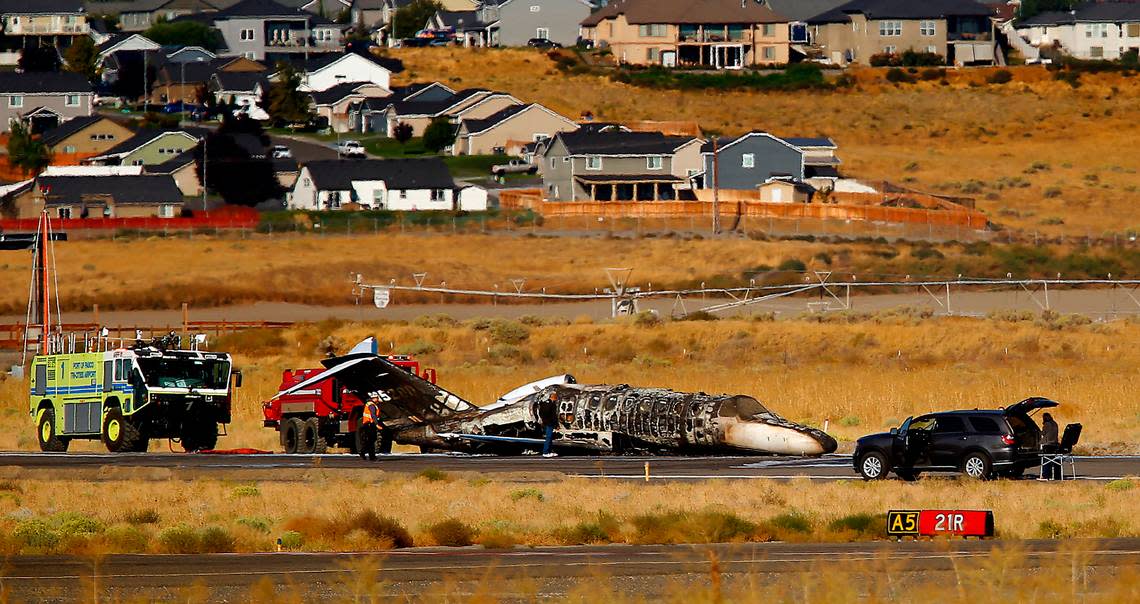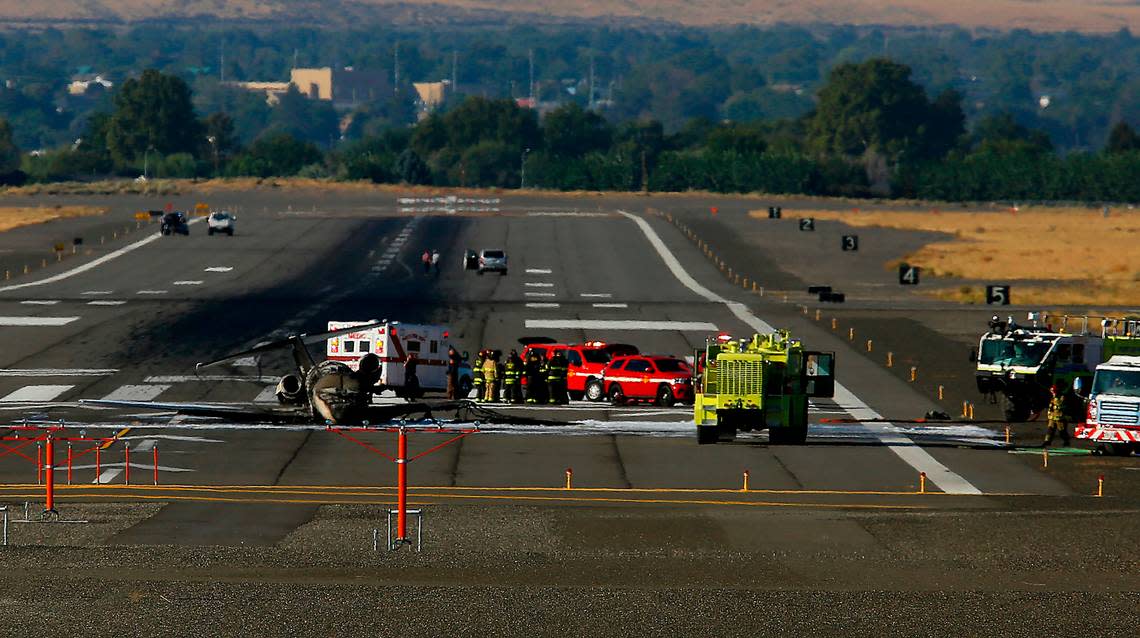What caused the fiery plane wreck at Tri-Cities Airport last month? New details
A new report on the fiery plane crash at the Tri-Cities airport last month offers insight into what caused the wreck.
The National Transportation Safety Board has issued a preliminary investigation report on the Sept. 20 crash, indicating it might not have been an equipment malfunction as initially believed.
As the Cessna 525B was coming in for a landing on a business flight, the pilot reported to the Tri-Cities Airport tower that the flight had been uneventful and requested to land.
The pilot then told the tower he had started to lower the flaps and extend the gear handle, according to the report. Investigators say the pilot did not recall confirming if the landing gear was down and locked, but reported that there were no warnings sounded.
The pilot said he realized the landing gear was not down just before making contact with the runway when the plane floated for longer than expected, according to the investigation.

The plane slid down the runway on its belly before coming to a stop near the departure end of the runway.
The report says the pilot secured the engines and began helping passengers to evacuate.
During the evacuation, he reported the plane was on fire near the right engine, before the plane became fully engulfed in flames.
Later, the burned-out fuselage was hauled to a secure facility for further inspection.
Investigation continues
A spokesperson for the NTSB said the preliminary report only shares facts, it is not intended to assign fault, and that the full investigation can take one to two years.
The spokesperson said the agency seeks to determine the cause of wrecks and contributing factors. The Federal Aviation Administration would investigate any actions taken toward a pilot’s license.
An FAA spokesman told the Herald in an email that the FAA looks at pilot performance as part of every accident investigation.
“Our safety inspectors may close some cases with counseling when an alleged violation is unintentional and the pilot is cooperative and not a repeat offender. In these instances, the agency often requires the pilot to undergo a proficiency check. If safety inspectors believe enforcement action against a pilot is warranted, they prepare a detailed case and present it to our attorneys,” the spokesman said.
If attorney believe there is enough evidence to take action, they then put together a legal case detailing the regulations the pilot is alleged to have violated, along with a proposed penalty, according to the FAA spokesman.
The penalties can range from warning to license suspension or revocation. The pilot has a right to appeal any actions to the FAA or an NTSB administrative law judge.

Tri-Cities Airport director Buck Taft told the Herald in an e-mail that the runway was damaged and has been closed since the crash and fire.
It is being repaired this week, and is expected to reopen on Tuesday. It was the first wreck of a passenger jet at the airport in more than three decades.
“Overall, it was a successful response,” Taft said. “We don’t get to deal with accidents like that very often.”
Private business jet
The small privately-owned jet was carrying surgical technicians and a registered nurse for the Pacific Cataract and Laser Institute when it began its approach at the Tri-Cities Airport just after 7 a.m. on Sept. 20.
They were flying in from Chehalis with 10 people aboard the Citation line Cessna aircraft, including the pilot. No one was injured.
The jet is one of three operated by the Pacific Cataract and Laser Institute.
Kris Gamboa, the site manager for the Kennewick location told the Herald at the time that it was carrying staff from the company’s headquarters in Chehalis to the Tri-Cities.
They had planned to drop off staff to work at the company’s Kennewick location before picking up a doctor and flying to Lewiston.
The company has 17 sites across the Northwest, and share staff among them. They perform surgeries for cataracts, glaucoma, corneal transplants and laser vision corrections.
The company canceled 30 planned surgeries in Kennewick and 24 in Lewiston on the day of the wreck, and brought the staff back to Chehalis by van.
This was second plane crash involving Pacific Cataract staff. In 2010, a twin engine Cessna carrying three people crashed in Lewis County.
According to an article in The Columbian, the plane began experiencing issues 10 minutes into its flight from Chehalis to Lewiston. It crashed in a remote area, killing all aboard.
The crash killed pilot Ken Sabin, Dr. Paul Shenk of Woodland and Rod Rinta, a Lewis County laser technician.
First in 30 years
The wreck was the first major plane crash at the Tri-Cities Airport in 30 years. While there have been some crashes of small engine, pilot-owned planes, a commercial aircraft last crashed in 1989, according to Herald archives.
Just two days after Christmas in 1989 all six people aboard a 19-seat British Aerospace Jetstream 31 died when the United Express passenger jet crashed and burned at the airport. The flight was coming from Seattle and Yakima.
The plane had a two man crew and was carrying four passengers — three men and a woman.
Initial reports said that the plane landed short of the runway and cartwheeled into an area adjacent to the runway, landing right-side-up. The front half of the plane then burst into flames and was gutted before firefighters could extinguish it.
The NTSB report from that crash cited pilot error, bad data from a Seattle air traffic control station and ice buildup on the plane.
